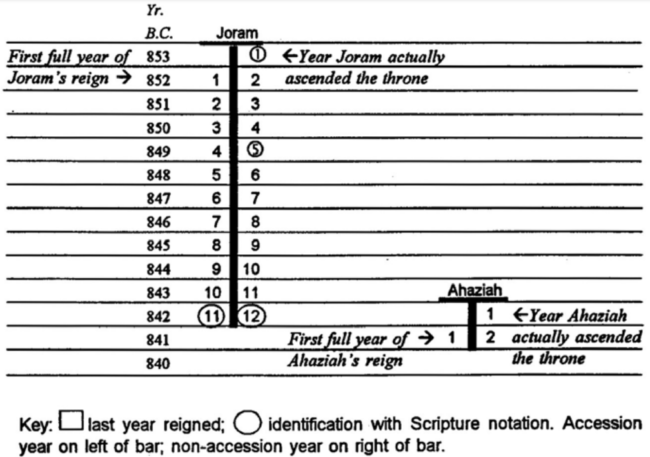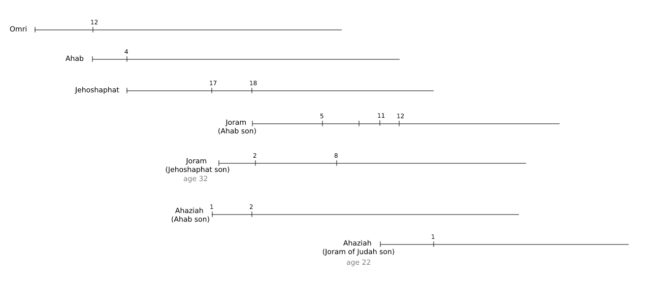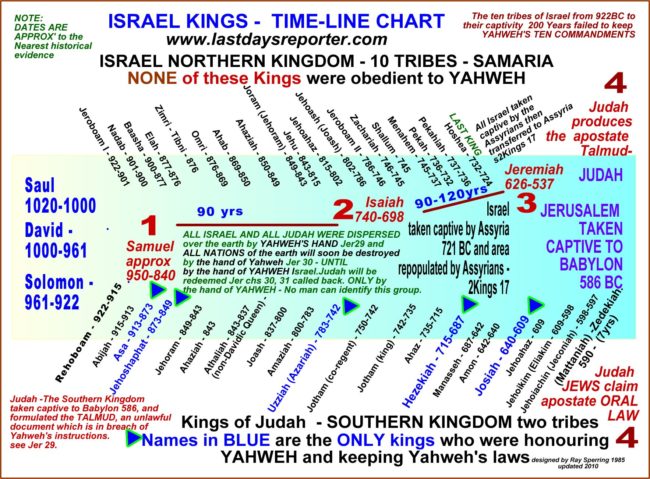PROBLEM
At the first sight, it seems that the folllowing 2 bible verses contradicts each other about the age of Ahaziah when he started to reign: one it says 22 and the other mentions 42.
In the twelfth year of Joram the son of Ahab king of Israel did Ahaziah the son of Jehoram king of Judah begin to reign.
Two and twenty (22) years old was Ahaziah when he began to reign; and he reigned one year in Jerusalem.And his mother’s name was Athaliah, the daughter of Omri king of Israel. 2 Kings 8: 25-26
And the inhabitants of Jerusalem made Ahaziah his youngest son king in his stead: for the band of men that came with the Arabians to the camp had slain all the eldest. So Ahaziah the son of Jehoram king of Judah reigned.
Forty and two (42) years old was Ahaziah when he began to reign, and he reigned 1 year in Jerusalem. His mother’s name also was Athaliah the daughter of Omri.
He also walked in the ways of the house of Ahab: for his mother was his counselor to do wickedly. 2 Chronicles 22: 1-3
SOLUTION
If you don’t know the biblical chronology of the kings of Judah and Israel you might get lost easily as there are more kings with the same name and with overlapping reign periods also.
In the following verses you’ll notice 2 similar kings name: Jehoram the son of Jehoshaphat (Judah king) and Jehoram the son of Ahab (Israel king) and Ahaziah the son of Jehoram king of Judah and Ahaziah the son of Ahab.
Another confusing part might be the biblical names “variations” for people and locations, as some bibles
translate the Greek names and others the Hebrew names. A very basic knowledge of greek and hebrew would
help a lot.
Keep in mind that most of hebrew names have a meaning !! For example, Emmanuel = God is
with us.
אַחְאָ֔ב (“ahav”) = Ἀχαάβ (“ahaab”) = Ahab
אֲחַזְיָה (“ahaziah”) = Οχοζια (“ohoxia”) = Ochoziam (latin) = Ahaziah = Ochosias
יְהוֹרָם (“iehoram”) = “father’s brother” = Ιωράμ (“ioram”) = Ioram (latin) = Jehoram = Joram
יְהוֹשָׁפָ֥ט (“iehoshaphat”) = “Jehovah has judged” = Ιωσαφατ (“iosaphat”) = Iosaphat (latin) = Jehoshaphat (Josaphat)
While most frequently a king ruled alone on the throne with no co-regency, there were kings who ruled under a co-regency with the previous king or a following king, in that case, the length of the reign can be:
- The total length of reign including the time of co-regency with the previous king or a following king
- The length of time he ruled alone, excluding the years of co-regency
- The length of time he ruled as the dominant king even though a co-regency was in effect
- Usually a king’s reign did not include a co-regency
Two methods of timekeeping were used:
-
The accession year system where the first official year is the year following the year the king begins to reign. This first year was, therefore, the first full year of a king’s reign. Thus, the last year of one king would not be the first official year of the next king; This first official year would be the year following the year the previous king died.
-
The non-accession year system where the first official year is the year the king begins to reign. Thus, the last year of one king would also be the first official year of the next king.

Because Solomon started to practice idolatry, God divided the 12 Israelite tribes: 10 of them were given to Jeroboam (1 Kings 11) becoming the Israel kingdom (in north) and the other 2 remained to Solomon’s son Rehoboam as Judah kingdom (in south).

In fact, we will find that in the nation of Judah, the duration of the reigns of every one of the kings was
according to the accession year system.
On the other hand, in the nation of Israel, the ten tribes, the duration of the reigns of the first eight kings was
according to the non-accession year system and after this, all of the reigns were in accordance
with the accession year system.
So for 2 Kings 8: 25 would be:

To start the ‘year’ calculations for Ahaziah age, let’s go back to Ahab, Omri and Jehoshaphat.
In the 31th year of Asa king of Judah began Omri to reign over Israel, 12 years: 6 years reigned he in Tirzah… But Omri wrought evil in the eyes of the LORD, and did worse than all that were before him. 1 Kings 16: 23 – 25
And in the 38th year of Asa king of Judah began Ahab the son of Omri to reign over Israel: and Ahab the son of Omri reigned over Israel in Samaria 22 years. 2 Kings 16: 29
Let’s see the co-regency of Asa and Jehoshaphat:

So Ahab slept with his fathers; and Ahaziah his son reigned in his stead. And Jehoshaphat the son of Asa began to reign over Judah in the 4th year of Ahab king of Israel.
Jehoshaphat was 35 years old when he began to reign; and he reigned 25 years in Jerusalem.
And his mother’s name was Azubah the daughter of Shilhi. 1 Kings 22: 40-42
Jehoram the son of Ahab became king over Israel at Samaria in the 18th year of Jehoshaphat king of Judah, and reigned 12 years. 2 Kings 3:1
And in the 5th year of Joram the son of Ahab king of Israel, Jehoshaphat being then king of Judah, Jehoram the son of Jehoshaphat king of Judah began to reign.
32 years old was he when he began to reign; and he reigned 8 years in Jerusalem.
And he walked in the way of the kings of Israel, as did the house of Ahab: for the daughter of Ahab was his wife: and he did evil in the sight of the LORD.. 2 Kings 8:16-18

Jehoshaphat rested with his fathers and was buried with them in the city of his ancestor David. His 1st son Jehoram became king in his place.
We see that Ahaziah died in the same year as of his father Ahab, in Samaria and according to the word of the LORD which Elijah had spoken. And because he had no son, his brother Jehoram became king over Israel, in his place, in the 2nd year (by the non-accession year system) of Jehoram (Joram) the son of Jehoshaphat, king of Judah. (2 Kings 1:17)
Ahaziah the son of Ahab began to reign over Israel in Samaria the 17th year of Jehoshaphat king of Judah, and reigned 2 years over Israel.
And he did evil in the sight of the LORD, and walked in the way of his father, and in the way of his mother, and in the way of Jeroboam the son of Nebat, who made Israel to sin.. 1 Kings 22: 51,52
Jehoram was 32 years old when he began to reign, and he reigned 8 years in Jerusalem. 2 Chronicles 21:5
And in the 11th year of Joram the son of Ahab began Ahaziah to reign over Judah. 2 Kings 9:29
Because of Jehoram’s (Israel king) great wickedness, God brought many terrible things into his life, including the fact that all of his sons except for the youngest, Jehoahaz (Azariah) were killed by Arabians (2 Chronicles 21:16-17).
Also in 2 Kings 9 we find out that Joram king of Israel (Ahab son) and Ahaziah king of Judah are killed by Jehu.
And he walked in the way of the house of Ahab, and did evil in the sight of the LORD, as did the house of Ahab: for he was the son in law of the house of Ahab. 2 Kings 8:27
The Hebrew word חָתָן (“hatan”) = son-in-law, means that Ahaziah was related by marriage to the house of Ahab because his father, Joram, king of Judah, was married to the granddaughter of Omri, the father of Ahab. Thus, Ahaziah was also related to the dynasty of Omri, king of Israel.
Ahaziah was part of two dynasties
He was the bloodline of David, whose dynasty began more than 150 years earlier, but he was also
a son of the dynasty of Omri, whose first full year began 42 years earlier, in 884
B.C.
The age of 22 year from 2 Kings 8:26 relates to his physical age when he began to reign
while the age of 42 from 2 Chronicles 22:2 relates to the age of the dynasty of Omri, of
which Ahaziah was part of.
You can calculate like this:
Omri 6 years (as king over all the house of Israel) +
Ahab 22 years +
Ahaziah (Ahab son) 2 years +
Jehoram (Ahab son) 12 years +
= 42
Thus, there is no contradiction between these 2 verses.

Another example of apparently contradiction: 1 Chronicles 3:10 <-> Matthew 1:7
In 1 Chronicles 3 we see David genealogy, the 6 sons born in Hebron and the 13 ones born in Jerusalem including here Solomon.
The 1 Chronicles 3:10 list the Solomon tree genealogy: Solomon > Rehoboam > Abijah > Asa (Asaph) > Jehoshaphat (Josaphat ) > Joram (Jehoram) > Ahaziah > Joash > Amaziah > Azariah > Jotham …
Which in greek looks like: Ιωραμ > Ὀχοζίας > Ιωας > Αμασιας > Αζαρια > Ιωαθαν > Αχαζ > Εζεκιας > Μανασσης > Αμων > Ιωσια > Ιωαναν….
But, at a superficial look it seems that Matthew 1:7 mistakes the above list: Roboam > Abia > Josaphat > Joram > Ozias (Uzziah) > Joatham (Jotham) > Ahaz > Hezekiah > Manasseh > Amon > Josiah …
with the greek names like: Ἰωρὰμ > Ὀζίας (Uzziah, Azariah) > Ἰωάθαμ > Ἄχαζ > Ἑζεκίας > Μανασσής > Αμών > Ιωσίαν > Ιεχονίαν…
As you can see, Matthew just gives a shorter list of Solomon descendants and it doesn’t change it.

References
The Perfect Harmony of the Numbers of the Hebrew KingsIsrael Kings Timeline Chart
